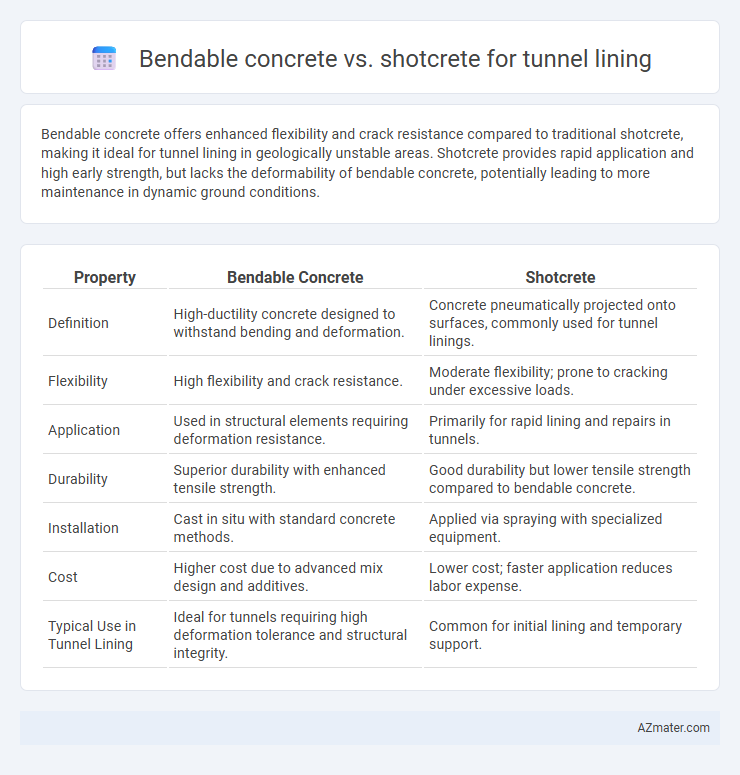Bendable concrete offers enhanced flexibility and crack resistance compared to traditional shotcrete, making it ideal for tunnel lining in geologically unstable areas. Shotcrete provides rapid application and high early strength, but lacks the deformability of bendable concrete, potentially leading to more maintenance in dynamic ground conditions.
Table of Comparison
| Property | Bendable Concrete | Shotcrete |
|---|---|---|
| Definition | High-ductility concrete designed to withstand bending and deformation. | Concrete pneumatically projected onto surfaces, commonly used for tunnel linings. |
| Flexibility | High flexibility and crack resistance. | Moderate flexibility; prone to cracking under excessive loads. |
| Application | Used in structural elements requiring deformation resistance. | Primarily for rapid lining and repairs in tunnels. |
| Durability | Superior durability with enhanced tensile strength. | Good durability but lower tensile strength compared to bendable concrete. |
| Installation | Cast in situ with standard concrete methods. | Applied via spraying with specialized equipment. |
| Cost | Higher cost due to advanced mix design and additives. | Lower cost; faster application reduces labor expense. |
| Typical Use in Tunnel Lining | Ideal for tunnels requiring high deformation tolerance and structural integrity. | Common for initial lining and temporary support. |
Introduction to Tunnel Lining Materials
Tunnel lining materials are critical for ensuring structural stability and durability in underground construction. Bendable concrete offers enhanced flexibility and crack resistance, making it ideal for tunnels subjected to ground movements, while shotcrete provides efficient application and high early strength for rapid support. Selecting between bendable concrete and shotcrete depends on project-specific factors such as geological conditions, load requirements, and installation speed.
Overview of Bendable Concrete Technology
Bendable concrete technology offers enhanced flexibility and crack resistance compared to traditional shotcrete, making it ideal for tunnel lining applications where structure deformation is expected. This innovative material incorporates engineered fibers that improve tensile strength and durability, reducing maintenance and repair costs over the tunnel's lifespan. Its ability to accommodate structural movements without significant damage ensures improved safety and long-term performance in challenging underground environments.
Understanding Shotcrete Applications
Shotcrete, a pneumatically applied concrete mixture, is extensively used for tunnel lining due to its excellent adhesion, rapid setting time, and adaptability to complex geometries. Unlike bendable concrete, which incorporates fiber reinforcement for enhanced flexibility and crack resistance, shotcrete offers immediate structural support and efficient application in irregular tunnel surfaces. Its high-performance formulation ensures durability, reduced rebound waste, and superior bonding to various substrate materials, making it a preferred choice for tunnel excavation and linings.
Mechanical Properties Comparison
Bendable concrete exhibits higher tensile strength and enhanced ductility compared to shotcrete, making it more resilient to crack propagation and deformation in tunnel lining applications. Shotcrete provides quick setting and high early strength, but its brittleness limits its ability to withstand sustained tensile stresses and dynamic loads. The superior flexural performance of bendable concrete contributes to improved structural integrity and longevity in underground constructions where mechanical flexibility is crucial.
Flexibility and Crack Resistance
Bendable concrete for tunnel lining exhibits superior flexibility and crack resistance due to its engineered microstructure that allows controlled deformation under stress, reducing the likelihood of brittle failure. Shotcrete, while effective for rapid application and initial support, tends to be more rigid and susceptible to cracking under dynamic loads or ground movements. The enhanced ductility of bendable concrete significantly improves long-term structural integrity in tunnels subject to varying geological pressures.
Durability and Longevity Analysis
Bendable concrete offers enhanced crack resistance and improved flexural strength compared to traditional shotcrete, resulting in superior durability under dynamic tunnel lining conditions. Shotcrete, while easier to apply in complex geometries, may experience micro-cracking and reduced longevity due to shrinkage and lower tensile capacity. Long-term performance studies indicate bendable concrete significantly extends tunnel lining lifespan by mitigating fatigue and deformation risks inherent to tunnel stress environments.
Installation Methods and Construction Speed
Bendable concrete offers increased flexibility and crack resistance, allowing for easier installation in curved or irregular tunnel linings through standard formwork techniques, which can reduce labor intensity and material wastage. Shotcrete application utilizes pneumatic spraying directly onto tunnel surfaces, enabling rapid placement and minimal formwork, significantly accelerating construction speed in confined or complex geometries. The choice between bendable concrete and shotcrete hinges on project-specific factors such as tunnel curvature, access constraints, and the desired balance between installation complexity and time efficiency.
Cost Implications and Resource Efficiency
Bendable concrete offers significant cost savings over shotcrete for tunnel lining due to its reduced material usage and lower labor intensity, resulting from enhanced crack resistance and durability. Shotcrete requires frequent application and maintenance, increasing overall expenses and resource consumption, whereas bendable concrete's superior flexibility minimizes repair needs and extends the service life of tunnel linings. Resource efficiency improves with bendable concrete by lowering cement demand and reducing energy consumption in repairs, making it a more sustainable choice for long-term tunnel infrastructure projects.
Environmental Impact and Sustainability
Bendable concrete for tunnel lining significantly reduces environmental impact by incorporating fiber reinforcement, minimizing brittle failure, and extending the lifespan of structures, thereby decreasing material consumption and waste generation. Shotcrete, while offering rapid application and strong adhesion, often involves higher cement content, leading to increased CO2 emissions and energy usage during production. The sustainability advantage of bendable concrete emerges from its enhanced durability and lower repair frequency, reducing resource demand and promoting greener tunnel construction practices.
Recommendations for Tunnel Lining Selection
Bendable concrete offers superior tensile strain capacity and crack control, making it highly effective for tunnel linings subjected to dynamic ground movements or seismic activity, while shotcrete provides rapid application and cost-efficiency for initial lining in stable ground conditions. For tunnels experiencing significant deformation or requiring long-term durability, bendable concrete is recommended due to its enhanced performance in strain-hardening and ductility. Shotcrete remains a practical choice for temporary support or less demanding geological environments, with consideration given to its limitations in flexibility and crack resistance.

Infographic: Bendable concrete vs Shotcrete for Tunnel lining
 azmater.com
azmater.com